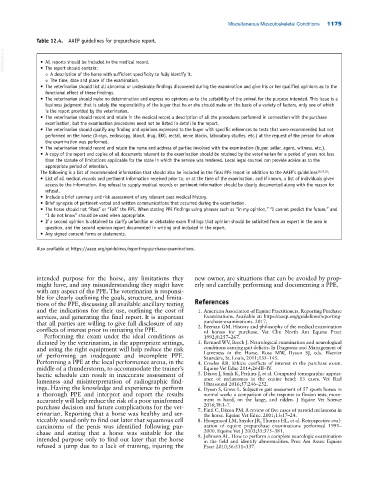Page 1209 - Adams and Stashak's Lameness in Horses, 7th Edition
P. 1209
Miscellaneous Musculoskeletal Conditions 1175
Table 12.4. AAEP guidelines for prepurchase report.
VetBooks.ir • All reports should be included in the medical record.
• The report should contain:
◦ A description of the horse with sufficient specificity to fully identify it.
◦ The time, date and place of the examination.
• The veterinarian should list all abnormal or undesirable findings discovered during the examination and give his or her qualified opinions as to the
functional effect of these findings.
• The veterinarian should make no determination and express no opinions as to the suitability of the animal for the purpose intended. This issue is a
business judgment that is solely the responsibility of the buyer that he or she should make on the basis of a variety of factors, only one of which
is the report provided by the veterinarian.
• The veterinarian should record and retain in the medical record a description of all the procedures performed in connection with the purchase
examination, but the examination procedures need not be listed in detail in the report.
• The veterinarian should qualify any finding and opinions expressed to the buyer with specific references to tests that were recommended but not
performed on the horse (X‐rays, endoscopy, blood, drug, EKG, rectal, nerve blocks, laboratory studies, etc.) at the request of the person for whom
the examination was performed.
• The veterinarian should record and retain the name and address of parties involved with the examination (buyer, seller, agent, witness, etc.).
• A copy of the report and copies of all documents relevant to the examination should be retained by the veterinarian for a period of years not less
than the statute of limitations applicable for the state in which the service was rendered. Local legal counsel can provide advice as to the
appropriate period of retention.
The following is a list of recommended information that should also be included in the final PPE report in addition to the AAEP’s guidelines 16,23,25 :
• List of all medical records and pertinent information received prior to, or at the time of the examination, and if known, a list of individuals given
access to the information. Any refusal to supply medical records or pertinent information should be clearly documented along with the reason for
refusal.
• Include a brief summary and risk assessment of any relevant past medical history.
• Brief synopsis of pertinent verbal and written communications that occurred during the examination.
• The horse should not “Pass” or “Fail” the PPE. When stating PPE findings using phrases such as “in my opinion,” “I cannot predict the future,” and
“I do not know” should be used when appropriate.
• If a second opinion is obtained to clarify unfamiliar or debatable exam findings that opinion should be solicited from an expert in the area in
question, and the second opinion report documented in writing and included in the report.
• Any signed consent forms or statements.
Also available at https://aaep.org/guidelines/reporting‐purchase‐examinations.
intended purpose for the horse, any limitations they new owner, are situations that can be avoided by prop
might have, and any misunderstanding they might have erly and carefully performing and documenting a PPE.
with any aspect of the PPE. The veterinarian is responsi
ble for clearly outlining the goals, structure, and limita
tions of the PPE, discussing all available ancillary testing References
and the indications for their use, outlining the cost of 1. American Association of Equine Practitioners. Reporting Purchase
services, and generating the final report. It is important Examinations. Available at: https://aaep.org/guidelines/reporting‐
that all parties are willing to give full disclosure of any purchase‐examinations. 2017.
conflicts of interest prior to initiating the PPE. 2. Beeman GM. History and philosophy of the medical examination
of horses for purchase. Vet Clin North Am Equine Pract
Performing the exam under the ideal conditions as 1992;8:257–267.
dictated by the veterinarian, in the appropriate settings, 3. Bernard WV, Beech J. Neurological examination and neurological
and using the right equipment will help reduce the risk conditions causing gait deficits. In Diagnosis and Management of
of performing an inadequate and incomplete PPE. Lameness in the Horse. Ross MW, Dyson SJ, eds. Elsevier
Saunders, St. Louis, 2011;135–145.
Performing a PPE at the local performance arena, in the 4. Cowles RR. Ethics: conflicts of interest in the purchase exam.
middle of a thunderstorm, to accommodate the trainer’s Equine Vet Educ 2014;26:III–IV.
hectic schedule can result in inaccurate assessment of 5. Dixon J, Smih K, Perkins J, et al. Computed tomographic appear
lameness and misinterpretation of radiographic find ance of melanomas in the equine head: 13 cases. Vet Rad
Ultrasound 2016;57:246–252.
ings. Having the knowledge and experience to perform 6. Dyson S, Greve L. Subjective gait assessment of 57 sports horses in
a thorough PPE and interpret and report the results normal work: a comparison of the response to flexion tests, move
accurately will help reduce the risk of a poor uninformed ment in hand, on the lunge, and ridden. J Equine Vet Science
2016;38:1–7.
purchase decision and future complications for the vet 7. Fintl C, Dixon PM. A review of five cases of parotid melanoma in
erinarian. Reporting that a horse was healthy and ser the horse. Equine Vet Educ. 2001;13:17–24.
viceably sound only to find out later that squamous cell 8. Hoogmoed LM, Snyder JR, Thomas HL, et al. Retrospective eval
carcinoma of the penis was identified following pur uation of equine prepurchase examinations performed 1991–
chase and stating that a horse was suitable for the 2000. Equine Vet J 2003;35:375–381.
intended purpose only to find out later that the horse 9. Johnson AL. How to perform a complete neurologic examination
in the field and identify abnormalities. Proc Am Assoc Equine
refused a jump due to a lack of training, injuring the Pract 2010;56:331–337.

